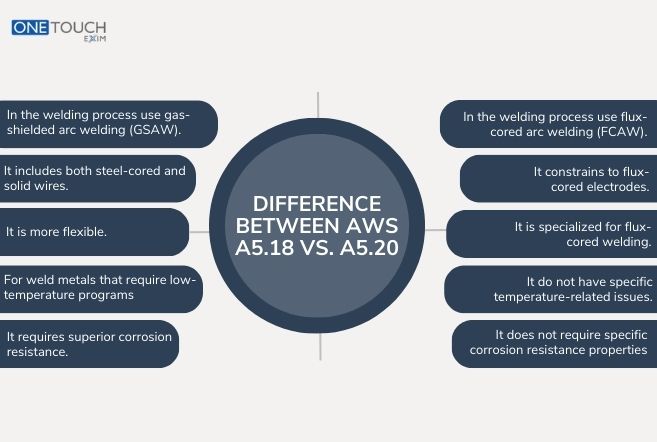When it comes to carbon steel electrodes and rods used in welding techniques, the American Welding Society (AWS) has installed two critical requirements: A5.18 vs. A5.20. These standards define the specs for carbon steel electrodes, wires, and rods, each with its own unique applications and features. In this blog post, we can delve into the differences between A5.18 and A5.20, discover their uses, and applications, and highlight the key features of those standards. Understanding those specifications is essential for welding experts to ensure the usage of suitable filler materials for various welding projects.
Key Features of A5.18 Standard
- Chemical Composition Requirements: The A5.18 specification defines appropriate chemical composition requirements for carbon steel electrodes and rods, ensuring the desired properties of the weld metallic.
- Physical Composition Needs: This standard also determines the mechanical property requirements for different types of rods and carbon steel electrodes, primarily based on the applications of the weld metal.
- Usability Characteristics: A5.18 acts as a manual for classifying and supplying records of the usability traits of rods and carbon metallic electrodes. This allows welding specialists to select the perfect metallic filler for their needs.
Key Features of A5.20 Standard
- Consistency with Superior Quality: A5.20 electrodes follow strict fine standards, making sure of constant and reliable performance over an extended duration. Welds produced by the usage of those electrodes exhibit superior quality and reliability.
- User-Friendly Application: Carbon metal electrodes that conform to A5.20 specifications have a user-friendly design, so even new welders can use them properly. These electrodes decrease spatter, improving typical welding efficiency.
- Absorbed-Moture Test Requirements: Designers intended A5.20 electrodes to meet absorbed-moisture test requirements. They are powerful in environments where moisture absorption should pose challenges at some point in the welding system.
- DH Evaluation Requirements: Carbon steel electrodes that comply with A5.20 specifications successfully meet Diffused Hydrogen (DH) review requirements. This assessment is crucial to make certain weld steel’s resistance to hydrogen diffusion at standard temperatures.
Differences Between Aws A5.18 vs. A5.20
The A5.18 standard known as Carbon Steel Electrodes and Rods for “Gas Shielded Arc Welding (GSAW)”, relates to carbon steel electrodes and rods used in gas shielded arc welding techniques. On the opposite hand, the A5.20 general, also called “Carbon Steel Electrodes for Flux-Cored Arc Welding (FCAW)” focuses on flux-cored gas-shielded wire for welding applications. The key variations among those requirements are as follows:
- Welding Process: We ordinarily use A5.18 electrodes for gas-shielded arc welding (GSAW), while we specifically design A5.20 electrodes for flux-cored arc welding (FCAW).
- Wire Types: A5.18 includes both steel-cored and solid wires, while we constrain A5.20 to flux-cored electrodes.
- Versatility: We usually consider A5.18 as more flexible, making it suitable for welding applications in an extensive range of industries and widespread functions. On the other hand, A5.20 is more specialized for flux-cored welding.
- Temperature Considerations: We frequently use A5.18 electrodes for weld metals that require low-temperature programs, whereas A5.20 electrodes do not have specific temperature-related issues.
- Corrosion Resistance: We prefer A5.18 electrodes when weld metals require superior corrosion resistance, whereas A5.20 does not provide specific corrosion resistance properties.
Uses and Applications of A5.18
- General-Purpose Fabrication: Carbon metal electrodes and rods conforming to A5.18 specifications are suitable for welding structural steels and sheets in general-motive fabrication programs. They offer reliable and efficient welds for an extensive range of tasks.
- Aerospace Welding: The A5.18 popular is generally applied for welding applications inside the aerospace enterprise. It guarantees the production of outstanding welds for vital additives which include landing gears, wings, and different crucial aircraft components.
Uses and Applications of A5.20
- Pre-Fabricated Construction: A5.20-exact electrodes and rods are widely utilized in pre-fabricated creation initiatives. These electrodes provide easy use and brief welding competencies, making them perfect for efficient and rapid assembly processes.
- Rail Car Repairs: In the restoration of rail motors, one of the commonplace troubles encountered is cracked frames. A5.20 electrodes, known for their high deposition charges, are nicely suitable for welding these cracked frames, ensuring the structural integrity of rail automobiles.
Conclusion
In conclusion, the A5.18 and A5.20 standards offer specifications for carbon metal electrodes and rods utilized in unique welding approaches. A5.18 is designed for gas-shielded arc welding (GSAW), while A5.20 specifically serves flux-cored arc welding (FCAW). A5.18 gives versatility, corrosion resistance, and suitability for widespread-motive fabrication and aerospace welding. Prefabricated production commonly uses A5.20 due to its high deposition charges and user-friendly application. Both requirements outline chemical and physical composition requirements, making sure favored properties and usefulness characteristics. A5.20 emphasizes consistency, moisture absorption checks, and subtle hydrogen reviews. Understanding the differences and key capabilities of A5.18 and A5.20 is critical for choosing suitable carbon metallic electrodes and rods for specific welding packages.
